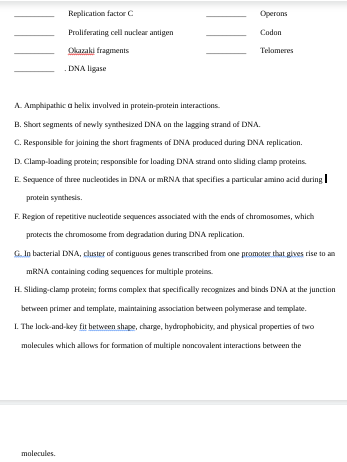Replication factor C Proliferating cell nuclear antigen Okazaki fragments DNA Ligase Operans Codon Telomeres A. Amphipathic a helix involved in protein-protein interactions. B. Short segments of newly synthesized DNA on the lagging strand of DNA. C. Responsible for joining the short fragments of DNA produced during DNA replication. D. Clamp-loading protein; responsible for loading DNA strand onto sliding clamp proteins. E. Sequence of three nucleotides in DNA or mRNA that specifies a particular amino acid during protein synthesis. F. Region of repetitive nucleotide sequences associated with the ends of chromosomes, which protects the chromosome from degradation during DNA replication. molecules. G. In bacterial DNA, cluster of contiguous genes transcribed from one promoter that gives rise to an mRNA containing coding sequences for multiple proteins. H. Sliding-clamp protein; forms complex that specifically recognizes and binds DNA at the junction between primer and template, maintaining association between polymerase and template. I. The lock-and-key fit between shape, charge, hydrophobicity, and physical properties of two molecules which allows for formation of multiple noncovalent interactions between the
Replication factor C Proliferating cell nuclear antigen Okazaki fragments DNA Ligase Operans Codon Telomeres A. Amphipathic a helix involved in protein-protein interactions. B. Short segments of newly synthesized DNA on the lagging strand of DNA. C. Responsible for joining the short fragments of DNA produced during DNA replication. D. Clamp-loading protein; responsible for loading DNA strand onto sliding clamp proteins. E. Sequence of three nucleotides in DNA or mRNA that specifies a particular amino acid during protein synthesis. F. Region of repetitive nucleotide sequences associated with the ends of chromosomes, which protects the chromosome from degradation during DNA replication. molecules. G. In bacterial DNA, cluster of contiguous genes transcribed from one promoter that gives rise to an mRNA containing coding sequences for multiple proteins. H. Sliding-clamp protein; forms complex that specifically recognizes and binds DNA at the junction between primer and template, maintaining association between polymerase and template. I. The lock-and-key fit between shape, charge, hydrophobicity, and physical properties of two molecules which allows for formation of multiple noncovalent interactions between the
Biology: The Dynamic Science (MindTap Course List)
4th Edition
ISBN:9781305389892
Author:Peter J. Russell, Paul E. Hertz, Beverly McMillan
Publisher:Peter J. Russell, Paul E. Hertz, Beverly McMillan
Chapter14: Dna Structure And Replication
Section: Chapter Questions
Problem 7TYK
Related questions
Question
Matching

Transcribed Image Text:Replication factor C
Proliferating cell nuclear antigen
Okazaki fragments
DNA Ligase
Operans
Codon
Telomeres
A. Amphipathic a helix involved in protein-protein interactions.
B. Short segments of newly synthesized DNA on the lagging strand of DNA.
C. Responsible for joining the short fragments of DNA produced during DNA replication.
D. Clamp-loading protein; responsible for loading DNA strand onto sliding clamp proteins.
E. Sequence of three nucleotides in DNA or mRNA that specifies a particular amino acid during
protein synthesis.
F. Region of repetitive nucleotide sequences associated with the ends of chromosomes, which
protects the chromosome from degradation during DNA replication.
molecules.
G. In bacterial DNA, cluster of contiguous genes transcribed from one promoter that gives rise to an
mRNA containing coding sequences for multiple proteins.
H. Sliding-clamp protein; forms complex that specifically recognizes and binds DNA at the junction
between primer and template, maintaining association between polymerase and template.
I. The lock-and-key fit between shape, charge, hydrophobicity, and physical properties of two
molecules which allows for formation of multiple noncovalent interactions between the
Expert Solution
Step 1
Introduction
Cell division is the process by which a single cell splits into two or more daughter cells. This occurs in all living organisms and is necessary for growth, repair, and reproduction. During cell division, the genetic material (DNA) of the parent cell is replicated and then divided equally among the daughter cells.
Step by step
Solved in 2 steps

Knowledge Booster
Learn more about
Need a deep-dive on the concept behind this application? Look no further. Learn more about this topic, biology and related others by exploring similar questions and additional content below.Recommended textbooks for you

Biology: The Dynamic Science (MindTap Course List)
Biology
ISBN:
9781305389892
Author:
Peter J. Russell, Paul E. Hertz, Beverly McMillan
Publisher:
Cengage Learning

Human Heredity: Principles and Issues (MindTap Co…
Biology
ISBN:
9781305251052
Author:
Michael Cummings
Publisher:
Cengage Learning

Biochemistry
Biochemistry
ISBN:
9781305577206
Author:
Reginald H. Garrett, Charles M. Grisham
Publisher:
Cengage Learning

Biology: The Dynamic Science (MindTap Course List)
Biology
ISBN:
9781305389892
Author:
Peter J. Russell, Paul E. Hertz, Beverly McMillan
Publisher:
Cengage Learning

Human Heredity: Principles and Issues (MindTap Co…
Biology
ISBN:
9781305251052
Author:
Michael Cummings
Publisher:
Cengage Learning

Biochemistry
Biochemistry
ISBN:
9781305577206
Author:
Reginald H. Garrett, Charles M. Grisham
Publisher:
Cengage Learning

Biology Today and Tomorrow without Physiology (Mi…
Biology
ISBN:
9781305117396
Author:
Cecie Starr, Christine Evers, Lisa Starr
Publisher:
Cengage Learning
